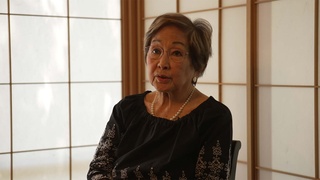Interviews
Larry’s fishing skill
And then also, when we lived over in Highland Park, we were right above the Arroyo Seco, this was before they had the Arroyo Seco freeway, the oldest freeway in California. And Busch Garden was in South Pasadena and after a big rain; all these exotic fish would go down into the Arroyo Seco. Well, nobody knew about it except my brother [Lawrence “Larry” Shinoda].
Well, the two of us knew about it and he figured out this engineering system where he could corral the fish and we could catch the fish. And so we developed a little business, we would sell the goldfish for a nickel a piece, and a nickel was a lot of money in those days. And we used to sell the goldfish; nobody knew where we got them.
And then he transferred the same skills when we went to Manzanar and he'd sneak out and get the fish and he'd catch them by hand and he had all these great fish and people would want to know where he got the fish. He went down to the fish, and he would catch them and no fisherman had that skill in Manzanar that was his unique skill. But he could always engineer things like that.
Date: September 9, 2011
Location: California, US
Interviewer: John Esaki
Contributed by: Watase Media Arts Center, Japanese American National Museum



